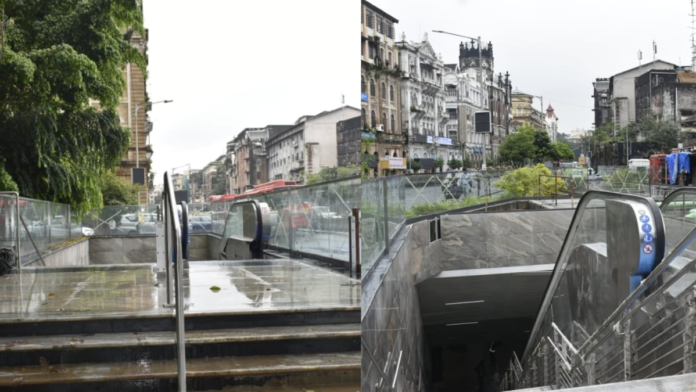Last Updated:
Mumbai Metro: Do you know how Mumbai-specific tunnelling challenges were handled? The process to the outcome, News18 takes you through the journey of making an underground Metro

Heritage architects were part of the planning process. (Photo Credits: Instagram)
For the country’s financial capital, Mumbai, where every inch of space is precious, a maze of Metro lines is being laid to ease commute. While some move along the overground or elevated route, for some areas, packed with commercial and residential complexes and sky high realty prices, the path is being laid underground through tunnelling.
The process to the outcome, News18 takes you through the journey of making an underground Metro.
How many underground Metro lines does Mumbai have?
The city’s first underground Metro line is Metro-3, a 33-5-km corridor that links Colaba to Bandra to Seepz. Tunnels pass beneath Marine Drive, CSMT Heritage Zone, Mithi River, existing rail corridors (WR, CR).
ALSO READ | Mumbai Metro-3 Ride From October 9: Know 6 Entry Points From Cuffe Parade, Frequency & Ticket Prices
Other lines such Metro 2B (DN Nagar-Mandale) has underground stretches near CSMT (still being planned); Mumbai Metro-4 (Wadala-Thane) has twin underground tunnels being planned in dense sections; Metro-11 (Wadala to Gateway extension of Line 4) will be entirely underground and Metro-9 (Dahisar to Mira-Bhayander) extension have been planned with underground sections.
Making of a Metro tunnel: What are the machines used?
1. Tunnel Boring Machines (TBMs) are primarily used in the process. They are massive cylindrical machines (80-100m long) that dig through soil/rock, while simultaneously laying tunnel segments.
They are used to achieve:
Minimal surface disruption in dense city zones
Ensuring precision under old buildings, roads, and utility lines.
A case in point: 17 TBMs had to be used while making Line 3, making it one of the largest TBM operations in India.
2. New Austrian Tunnelling Method (NATM): This is another method used for the process, although not as frequently as a TBM. It relies on controlled blasting and spray concrete support and is suitable for hard rock conditions. It used only in cases where TBMs are less feasible or in shorter stretches.
For Metro-3, some short sections used NATM to build station access tunnels. In case of Metro-4, TBMs will be used for tunnelling under Thane Creek and dense urban pockets and NATM for tricky transitions into elevated segments. In case of Metro-11, TBM will be used. For Metro-9, which has short underground portions near dense city nodes, a mix of cut-and-cover for shallow tunnels will be used.
Metro tunnel: Why is it an engineering feat?
Heritage sites: The tunnels for Mumbai Metro lines pass under heritage sites. For instance, in case of Mumbai Metro-3, the line will pass under CSMT, Flora Fountain and Marine Drive. As scenic as it may sound, it requires detailed geotechnical surveys and vibration monitoring to avoid structural damage.
Crowded subsurface: The tunnels have to avoid existing rail lines (WR & CR), sewerage lines, gas mains, telecom ducts, and storm drains. So they are often bored at 25-40m depth to stay below these utilities.
ALSO READ | Mumbai’s Metro 3 Opens Fully On October 8: The Aarey To Cuffe Parade Line Was In The Making For 8 Years
Water ingress: South Mumbai has high water tables and reclaimed land, which, in turn, raise flooding risks. Waterproof tunnel segments, sealing rings, and real-time groundwater pressure monitoring is used to reduce this risk.
Digital monitoring systems: Tunnelling involves the use of real-time deformation sensors, ground movement detectors, AI-based TBM control software to enable adjustments to TBM pressure and speed in response to soil changes.
Mumbai Metro tunnels: What are the risks involved?
News18 asked ChatGPt and here’s the table it threw up:
| Risk | Mitigation |
| Ground subsidence | Real-time monitoring, controlled boring, compensation grouting |
| Damage to old buildings | Structural audits, vibration dampeners, legal notifications |
| Utility strikes | Pre-surveys with GPR (ground-penetrating radar), coordination with BMC |
| Flooding/ water ingress | Pre-injection grouting, sealed segments, 24/7 sump systems |
| Human safety | Strict SOPs, emergency exits every 250m, fire suppression systems |
| Cost overruns & delays | Modular construction, global consultants (e.g., AECOM, MMRC) |
How did Mumbai still manage the underground work?
One of the key elements in the process was taking assistance through global consortia from Japan, China, Italy, Turkey, and India wherever required. Another was involvement of world-class engineering firms for tunnel alignment, seismic resilience, and ventilation systems.
Do you know innovative ways in which Mumbai-specific tunnelling challenges were handled?
Here are some examples from media reports:
Mumbai’s underground has hard basalt, so TBMs had to be customised and even get cutter-head design to handle varying strata from clay to basalt.
Cross-passages had to be built for emergency evacuation and air circulation between twin tunnels.
In some cases, media reports highlighted how robotic scanning was used to detect cracks inside finished tunnels.
A station like BKC is designed to be LEED-certified, with natural ventilation shafts and solar-equipped roofs (above ground entry points).
Explained: Mumbai Metro Has Two ‘All-Women’ Staff Stations: Do You Know Which Are They?
To tunnel below Mithi River, reports highlighted that special TBM pressure calibration and flood-proof tunnel rings had to be used.
For precise alignment while crossing the already existing Metro-1, which is elevated, 3D digital twin models were used.
For cramped areas like Girgaon, top-down construction method was used to minimise footprint and impact on the residents.
With Agency Inputs
The News Desk is a team of passionate editors and writers who break and analyse the most important events unfolding in India and abroad. From live updates to exclusive reports to in-depth explainers, the Desk d…Read More
The News Desk is a team of passionate editors and writers who break and analyse the most important events unfolding in India and abroad. From live updates to exclusive reports to in-depth explainers, the Desk d… Read More
October 07, 2025, 17:53 IST
Read More



